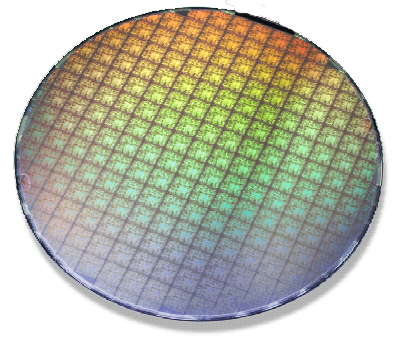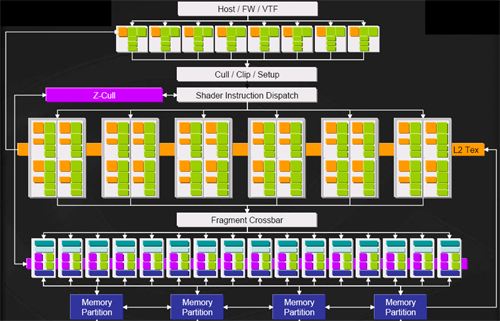NVIDIA's GeForce 7800 GTX Hits The Ground Running
by Derek Wilson on June 22, 2005 9:00 AM EST- Posted in
- GPUs
The Pipeline Overview
First, let us take a second to run through NVIDIA's architecture in general. DirectX or OpenGL commands and HLSL and GLSL shaders are translated and compiled for the architectures. Commands and data are sent to the hardware where we go from numbers, instructions and artwork to a rendered frame.The first major stop along the way is the vertex engine where geometry is processed. Vertices can be manipulated using math and texture data, and the output of the vertex pipelines is passed on down the line to the fragment (or pixel) engine. Here, every pixel on the screen is processed based on input from the vertex engine. After the pixels have been processed for all the geometry, the final scene must be assembled based on color and z data generated for each pixel. Anti-aliasing and blending are done into the framebuffer for final render output in what NVIDIA calls the render output pipeline (ROP). Now that we have a general overview, let's take a look at the G70 itself.

The G70 GPU is quite a large IC. Weighing in at 302 million transistors, we would certainly hope that NVIDIA packed enough power in the chip to match its size. The 110nm TSMC process will certainly help with die size, but that is quite a few transistors. The actual die area is only slightly greater than NV4x. In fact, NVIDIA is able to fit the same number of ICs on a single wafer.

A glance at a block diagram of the hardware gives us a first look at the methods by which NVIDIA increased performance this time around.

The first thing to notice is that we now have 8 (up from 6) vertex pipelines. We still aren't vertex processing limited (except in the workstation market), but this 33% upgrade in vertex power will help to keep the extra pixel pipelines fed as well as handle any added vertex load developers try to throw at games in the near future. There are plenty of beautiful things that can be done with vertex shaders that we aren't seeing come about in games yet like parallax and relief mapping as well as extended use of geometry instancing and vertex texturing.
Moving on to pixel pipelines, we see a 50% increase in the number of pipelines packed under the hood. Each of the 24 pixel pipes is also more powerful than those of NV4x. We will cover just why that is a little later on. For now though, it is interesting to note that we do not see an increase in the 16 ROPs. These pipelines take the output of the fragment crossbar (which aggregates all of the pixel shader output) and finalizes the rendering process. It is here where MSAA is performed, as well as the color and z/stencil operations. Not matching the number of ROPs to the number of pixel pipelines indicates that NVIDIA feels its fill rate and ability to handle current and near future resolutions is not an issue that needs to be addressed in this incarnation of the GeForce. As NVIDIA's UltraShadow II technology is driven by the hardware's ability to handle twice as many z operations per clock when a z only pass is performed, this also means that we won't see improved performance in this area.
If NVIDIA is correct in their guess (and we see no reason they should be wrong), we will see increasing amounts of processing being done per pixel in future titles. This means that each pixel will spend more time in the pixel pipeline. In order to keep the ROPs busy in light of a decreased output flow from a single pixel pipe, the ratio of pixel pipes to ROPs can be increased. This is in accord with the situation we've already described.
ROPs will need to be driven higher as common resolutions increase. This can also be mitigated by increases in frequency. We will also need more ROPs as the number pixel pipelines are able to saturate the fragment crossbar in spite of the increased time a pixel spends being shaded.










127 Comments
View All Comments
multiblitz - Sunday, June 26, 2005 - link
It would be great of you could do a comparison between the 6800 and the 7800 in video /DVD-playback-quality similar to the comparison betwenn the X800 and the 6800 you did last year.at80eighty - Saturday, June 25, 2005 - link
OMG! I've never seen so many bitching whiners come outta the woodworks like this!!You A-holes oughta remember that this site has been kept free
F
R
E
E
The editors owe YOU nothing. At all.
AT team - accidents happen. Keep up the great work!
/#121 : well said. Amazing how these turds dont realise that the knife cuts both ways...
mrdeez - Friday, June 24, 2005 - link
#124You can stfu too...j/k..point taken .
I guess the real issue for me is that this card is a beast but ill never have it in my sli rig......i want all settings maxed at playable resolutions thats just me.........and i will not go back to crt...lol crt thats was lame dude
Momental - Friday, June 24, 2005 - link
#122 The problem with your solution regarding "all of us just getting two 6880U's" works perfectly for those with an SLI-capable board, yes? Some of us, like myself, anticpated the next generation of GPU's like the 7800 series and opted to simply upgrade to one of those when the dust settled and prices slid back a bit.Additionally, telling someone to "STFU" isn't necessary. We can't hold a conversation if we're all silent. Knowhuddamean, jellybean? Hand gestures don't work well over the internet, but here's one for you..........
SDA - Friday, June 24, 2005 - link
LCD gamers shouldn't be bothering with new graphics cards, they should get new monitors.kidding, I have nothing against LCDs. The real advantage of showing the card run at 2048x1536 is that it lets you see how well the card scales to more stressful scenarios. A card that suddenly gets swamped at higher resolutions will probably not fare well in future games that need more memory bandwidth.
On a side note, you can get a CRT that will run 2048x1536 @ a reasonable refresh for about $200 shipped (any Sony G520 variant, such as the Dell P1130). The only things that would actually be small in games are the 2D objects that have set pixel sizes, everything else looks beautiful.
mrdeez - Friday, June 24, 2005 - link
#121lol ty for your insight....anyway like i said this card is not for lcd gamers as most have a 12x10 or 16x12.....so what purpose does this card have??answer me this batman and you have the group that should buy this card -otherwise, the rest of us should just get 2 6800u....this card is geared more for workstation graphics not gaming.....unless you game on a hi def crt and even then max res would be 1920 by 1080i..or something like that.....
SDA - Friday, June 24, 2005 - link
#116, if people in the comments thread are allowed to give their opinions, why shouldn't #114 give his too? Surely even an illiterate like you should realize that arguing that everyone is entitled to his or her own argument means that the person you're arguing with is too.#119, some people have different requirements than others. Some just want no visible blur, others want the best contrast ratio and color reproduction they can get.
bob661 - Thursday, June 23, 2005 - link
#188Oh yeah. The monitor goes up to 16x12.
bob661 - Thursday, June 23, 2005 - link
#118I play BF2 on a Viewsonic VP201b (20.1") at work and it's very good. No streaking or ghosting. Video card is a 6800GT. I play at 1280x960.
Icehawk - Thursday, June 23, 2005 - link
Well, I for one think 1280x1024 is pretty valid as that is what a 19" LCD can do. I'd just want to see a maxed out 12x10 chart to see how it does - I know a 6800 can't do it for every game with full AA and AF. Otherwise I agree - a 12x10 with no options isn't going to show much with current games.See, I'm considering swapping my two 21" CRTs for two 19" LCDs - and they won't do more than 12x10. I'd love to do two 20-21" LCDs but the cost is too high and fast panels aren't to be found. 19" is the sweet spot right now IMO - perhaps I'm wrong?
Thanks AT for a nice article - accidents happen.